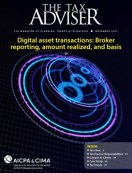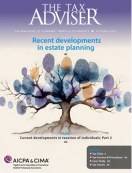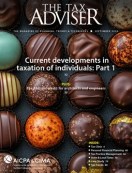- column
- CASE STUDY
Changing an existing LLC’s federal income tax classification
Related
PTEs need more notice of changes, more time to respond, AICPA says
Tax Court applies limited partner functional test for self-employment income
Final partnership adjustment not issued timely
A limited liability company (LLC) can change its entity classification for tax purposes by filing Form 8832, Entity Classification Election, or by incorporating under state law. These and other conversion options come with their particular tax and other considerations.
Changing LLC classification from partnership to corporation
In such a change, however, gain recognition may be an issue even in a relatively straightforward check–the–box entity election using Form 8832 or in a tax–free reorganization under Sec. 351.
Filing Form 8832 to elect corporate classification for tax
When an LLC classified as a partnership elects to change its classification to a corporation by filing Form 8832, the LLC is deemed to contribute all of its assets and liabilities to the corporation in exchange for stock in the corporation (Regs. Sec. 301.7701–3(g)(1)). This deemed contribution is generally tax–free under Sec. 351, provided the contributor(s) control the corporation immediately after the assets are transferred. Control means owning at least 80% of the stock (by vote and value). The LLC is then deemed to liquidate by distributing the corporate stock to its members, so after the deemed transaction, the LLC members are deemed to own stock in the corporation. This deemed liquidation is taxed under the Sec. 731 rules for liquidating partnership distributions. When an LLC elects to change to corporate classification, the parties do not actually form a corporation since the LLC still exists under state law. Only the federal tax classification changes.
Planning tip: Even if the rules for a tax–free incorporation under Sec. 351 are met, gain is still recognized if the corporation assumes liabilities in excess of the contributor’s tax basis in the contributed assets (Sec. 357(c)). If the LLC’s deemed contribution of its assets and liabilities to a corporation would result in a gain under Sec. 357(c), members of an LLC classified as a partnership could have the LLC actually distribute its assets and liabilities to them in liquidation of the LLC (taxed as a partnership liquidation under Sec. 731). The members would then contribute those assets and liabilities to a newly formed corporation in a transaction intended to be tax–free under Sec. 351. However, because the members generally take a carryover basis in the assets distributed from the LLC, in most cases, they would still have a Sec. 357(c) problem unless they contribute additional cash or other property to ensure that the liabilities contributed to the corporation do not exceed the basis of the contributed assets. Another option is to have the LLC members contribute their own promissory notes to cover the difference between their tax basis in the contributed assets and the liabilities assumed by the corporation (Lessinger, 872 F.2d 519 (2d Cir. 1989)).
Rev. Rul. 2009–15 clarifies that when an LLC classified as a partnership for tax changes to corporate classification (either by a state law formless conversion or by filing Form 8832), it is eligible to make an S election for its first tax year. Also, the conversion does not result in a short C corporation tax year.
Observation: In IRS Letter Ruling 201624003, an LLC that was classified as a partnership attempted to change its classification to an S corporation. But it was considered to have a second class of stock due to boilerplate provisions included in its operating agreement that allowed for non–pro rata distributions based on the members’ ownership percentages. Though the ruling concluded that the circumstances resulting in the S election’s ineffectiveness were inadvertent and therefore did not terminate the election, it allows one to see the IRS’s thinking in such circumstances. Clearly, if an LLC wants to change to S corporation classification, its operating agreement should not contain any provisions that would violate the S corporation qualification rules.
Practice tip: The IRS will allow LLCs classified as S corporations to correct nonidentical provisions in their operating agreement (provisions that could result in a second class of stock, such as a provision calling for non–pro rata distributions) (Rev. Proc. 2022–19, §3.06). LLCs classified as S corporations can use the Rev. Proc. 2022–19 relief provisions if they (1) have not made (and are not deemed to have made) disproportionate distributions; (2) timely filed their Form 1120–S, U.S. Income Tax Return for an S Corporation, for each year beginning with the tax year in which the first nonidentical provision was adopted and through the year immediately before the year in which they request relief; and (3) file the corrective relief statements as described in Section 3.06(2)(c) of the revenue procedure before the IRS discovers any nonidentical provision. If the LLC does not qualify for this corrective relief, it must seek relief by filing a letter ruling request.
Changing from partnership classification by incorporating
Instead of electing to change its federal tax classification by filing Form 8832, as described above, an LLC classified as a partnership can convert to a corporation under state law. First a corporation must be formed, then one of the following transactions can take place, as outlined in Rev. Rul. 84–111:
- LLC transfers assets to the corporation: Transfer the LLC’s assets and liabilities to the corporation in exchange for stock and then liquidate the LLC by distributing the corporate stock to the LLC members. This would have the same tax consequences as the deemed transaction described above.
- LLC members transfer assets to the corporation: Distribute the LLC’s assets and liabilities to the members in a liquidation taxed under Sec. 731. The members then contribute the assets and liabilities to the corporation in exchange for stock in a transaction intended to be tax-free under Sec. 351.
- LLC members transfer LLC interests to the corporation: Transfer the LLC ownership interests to the corporation in exchange for stock (which will cause the LLC’s partnership tax status to terminate under Sec. 708(b)(1) because it no longer has at least two partners).
Because it is necessary to actually form a corporation under state law and transfer assets, liabilities, and stock consistent with the form of the transaction chosen, this option has different legal results than keeping the LLC intact and electing to change its classification for federal tax purposes. Actually converting the LLC to a corporation may result in lease terminations, reappraisals of property, or the need to obtain creditor consent. In Rev. Rul. 2004–59, the IRS looked at the tax consequences of an LLC (classified as a partnership) converting to a state–law corporation under a state statute that does not require an actual transfer of the unincorporated entity’s assets or interests (i.e., a state–law formless conversion statute). After noting that Rev. Rul. 84–111 does not apply when a partnership converts into a corporation in accordance with a state–law formless conversion statute, the IRS ruled that the LLC was deemed to contribute all of its assets and liabilities to the corporation in exchange for stock. The LLC was then deemed to liquidate and distribute the corporate stock to its members.
If a cash–basis LLC classified as a partnership transfers all its assets and liabilities to a new corporation as part of the incorporation of an ongoing business, general nonrecognition rules apply under Sec. 351, and the LLC recognizes no income from the transfer of the cash–basis receivables (Hempt Bros., Inc., 490 F.2d 1172 (3d Cir. 1974); Rev. Rul. 80–198). In other words, the receivables generate taxable income only when collected by the corporation. Assignment–of–income principles are not applied to the LLC. This might not be the case if there is evidence of a tax–avoidance motive or manipulation, such as the accumulation of receivables or prepayment of payables inconsistent with past practice (Rev. Rul. 80–198). In addition, the IRS may apply other reasoning, for example, to ensure the clear reflection of income, to cause the transferor to recognize the income from transferred accounts receivable. In Palmer, 267 F.2d 434 (9th Cir. 1959), the Ninth Circuit required an incorporating partnership that used the completed–contract method to adopt the percentage–of–completion method with respect to transferred long–term contracts in order to clearly reflect income.
In certain situations, a corporation receiving assets from an incorporating partnership (including an LLC classified as such) may have to recognize income based on tax–benefit principles. In Rev. Rul. 79–127, a new corporation received substantially all of an incorporating partnership’s assets, including its inventory valued using the lower–of–cost–or–market method, and elected to use the LIFO method valuing the inventory at cost for its first tax year. The corporation was taxed on the market write–downs restored to its opening inventory to raise it to cost.
Issues when the LLC converting to corporate status has Sec. 704(c) property
Sec. 704(c) property is property that is contributed to a partnership when its tax basis does not equal its fair market value (FMV). When members of an LLC that is classified as a partnership contribute Sec. 704(c) property to the partnership, the built–in gain or loss associated with that property must be allocated to the contributing member under the Sec. 704 partnership income allocation rules because, economically, the gain or loss is attributable to that member’s ownership of the property before the property was contributed to the LLC (Sec. 704(c)(1)(A)).
If an LLC changes from partnership to corporate classification, either by incorporating in one of the transactions described above or by filing Form ٨٨٣٢, the partnership rules for allocating built–in gain or loss to the member who contributed Sec. 704(c) property no longer apply. If the LLC elects S status after converting to corporate classification, the rules for allocating S corporation income will allocate a pro rata share (based on stock ownership) of any gain or loss, including any built–in gain or loss, to the noncontributing partner(s) when the Sec. 704(c) property is eventually sold. Unlike what would happen if the LLC continued to be classified as a partnership, the member who contributed the Sec. 704(c) property would not be allocated the entire built–in gain or loss. Similarly, if the LLC changes its classification to a C corporation, when the LLC (now classified as a C corporation for tax) sells the Sec. 704(c) property, the corporate–level tax on any gain, including any built–in gain, reduces all the shareholders’ stock value regardless of whether they contributed the appreciated property.
Example 1. Incorporating a partnership that has Sec. 704(c) property: On Jan. 1, 20X1, M and T form M&T LLC, which will be classified as a partnership for federal income tax purposes. M contributes $1,000 in exchange for a 50% interest in the LLC, and T contributes Lot A with a $500 basis and an FMV of $1,000 for a 50% interest.
On Jan. 1, 20X2, M and T decide to incorporate the partnership as an S corporation. To accomplish this, the LLC transfers all its assets and liabilities to a newly formed corporation (NewCo). In exchange, NewCo issues 50 shares of common stock each to M and T. This is a tax–free exchange under Sec. 351. Assume the LLC’s tax basis in its assets was greater than its liabilities, so no Sec. 357(c) gain is recognized.
Later in the year, NewCo sells Lot A for $1,000, resulting in a $500 gain ($1,000 sales proceeds – $500 basis). Because NewCo is an S corporation, M and T are each allocated their pro rata share of this gain based on their stock ownership ($250 gain allocated to each shareholder) (Sec. 1377(a)). So, T, who did not contribute the property with the built–in gain, is taxed on half the built–in gain with respect to the appreciated property M contributed to the LLC.
To mitigate the shift in tax liability, the partners could arrange to compensate T for the tax he must pay, as a result of the incorporation, on the gain that occurred while M owned the property.
Changing LLC classification from corporation to partnership
Although most multimember LLCs elect to be classified as partnerships for federal income tax, there are situations where they choose to be classified as C or S corporations and then decide to change to partnership status. This classification change can be made by filing Form 8832. An LLC classified as a corporation that elects to be classified as a partnership is deemed to distribute all of its assets and liabilities to its members in liquidation of the LLC, and immediately thereafter, the members are deemed to contribute all of the distributed assets and liabilities to a newly formed partnership (Regs. Sec. 301.7701–3(g)(1)(ii)).
Caution: Changing from being classified as a corporation to a partnership is deemed to be a complete liquidation of the corporation, often resulting in a double tax (corporate–level gain on the excess of the corporate assets’ FMV over their basis, plus shareholder gain on the excess of the cash and FMV of property received over the shareholder’s basis in the stock). In many circumstances, the tax cost of converting from C corporation classification outweighs any benefits. When an LLC changes its classification from S corporation to partnership, the tax cost may be less, since tax on any appreciation in the LLC’s assets is taxed only once.
When an LLC classified as a corporation elects to change its status to partnership by filing Form 8832, a corporate owner that owns at least 80% of the LLC generally would not recognize gain or loss on the LLC’s deemed liquidation under Sec. 332, provided a formal plan of liquidation is filed. A formal plan of liquidation is deemed to be adopted immediately before the liquidation when the LLC files Form 8832 to change its status (if a formal plan was not already adopted) (Regs. Sec. 301.7701–3(g)(2)(ii)). This allows a corporate owner of the liquidating entity to comply with Sec. 332.
Changing LLC classification from corporation to disregarded entity
A single–member LLC (SMLLC) that is classified as a corporation can elect to change its classification to disregarded entity by filing Form 8832. If it does, the SMLLC is deemed to distribute all of its assets and liabilities to its single owner in liquidation (Regs. Sec. 301.7701–3(g)(1)(iii)). This deemed transaction is taxed as a liquidation of a corporation. If the owner of the SMLLC is a corporation, this would generally be a tax–free liquidation under Sec. 332. Otherwise, the liquidating distribution is treated as full payment in exchange for the stock (Sec. 331). In other words, the distribution will be considered a taxable transaction.
Changing LLC classification from disregarded entity to corporation
An SMLLC that is a disregarded entity can elect to change its classification to a corporation by filing Form 8832. If it does, the SMLLC’s owner is deemed to contribute all of the LLC’s assets and liabilities to the corporation in exchange for the corporation’s stock (Regs. Sec. 301.7701–3(g)(1)(iv)). This is generally tax–free under Sec. 351 unless liabilities in excess of the assets’ tax basis are contributed (Sec. 357(c)).
Limits on changing an entity’s classification
If an entity elects to change its classification, it cannot change its classification again during the 60 months after the election’s effective date (Regs. Sec. 301.7701–3(c)(1)(iv)). This rule does not apply to a newly formed entity’s election out of its default classification at inception. Furthermore, the limitation does not apply if the organization’s business is actually transferred to another entity. If a more–than–50% change in ownership occurs within the 60–month period, the IRS may approve a classification change (see Letter Rulings 200426012, 200535016, and 200836004 for examples of how this rule applies).
Observation: In Letter Ruling 201233007, the Service ruled that where an LLC was formed with no assets and was completely dormant, a subsequent election to be classified as a corporation was an initial classification election and not a change in classification.
Timing of an elective classification change
An election to change an LLC’s classification is treated as occurring at the start of the day for which the election is effective (unless a formal plan of liquidation adopts an earlier date) (Regs. Sec. 301.7701–3(g)(3)). The transactions that are deemed to occur as a result of the new classification are deemed to occur immediately before the close of the day before the election is effective.
Example 2. Deemed date of transfer: The members of C LLC, which is classified as a partnership, filed a Form 8832 electing corporate status effective Jan. 1, 20X1. C is deemed to transfer all of its assets to a corporation on Dec. 31, 20X0.
In two special cases, the regulations provide that (1) if a purchasing corporation makes a Sec. 338 election regarding its acquisition of another entity and makes an election to change the classification of the target entity, the deemed transactions resulting from the reclassification are treated as occurring immediately after the deemed asset purchase by the new target corporation under Sec. 338 (Regs. Sec. 301.7701–3(g)(3)(ii)); and (2) when reclassification elections are made for a series of tiered entities and no order for the elections is specified on Form 8832, the deemed transactions are treated as occurring first for the highest–tier entity, then for the next–highest tier (Regs. Sec. 301.7701–3(g)(3)(iii)).
Federal employer identification number
Under Regs. Sec. 301.6109–1(h), a multimember entity retains its federal employer identification number (EIN) after a classification change. A disregarded entity generally must use its owner’s EIN until it becomes a separately recognized entity either by election or a change in its number of members, at which time it must obtain its own EIN if it does not already have one. However, a disregarded SMLLC is treated as a separate entity for employment taxes and must use its own EIN.
Contributor
Shaun M. Hunley, J.D., LL.M.,is an executive editor with Thomson Reuters Checkpoint. For more information about this column, contact thetaxadviser@aicpa.org. This case study has been adapted from Checkpoint Tax Planning and Advisory Guide’s Limited Liability Companies topic. Published by Thomson Reuters, Frisco, Texas, 2025 (800-431-9025; tax.thomsonreuters.com).














